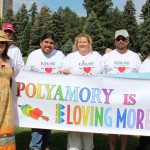The Array of Designer Relationships in Polyamory
 Book Excerpt from What Does Polyamory Look Like? Polydiverse Patterns of Loving and Living in Modern Polyamorous Relationships By Mim Chapman, PhD
Book Excerpt from What Does Polyamory Look Like? Polydiverse Patterns of Loving and Living in Modern Polyamorous Relationships By Mim Chapman, PhD
Publisher: iUniverse.com, August, 2010
Available through the Loving More bookstore.
Polyamory is sometimes described as many ways of loving, not just many loves. To be totally honest, most of us don’t really have all that many loves…after all, although love is unlimited, time and emotional energy do have limits! Similarly, there really aren’t all that many family formations or ways of loving, but with polyamory comes the freedom, and the challenge, of creating whatever type of relationship works for individual people and their partner(s).
If you’re new to poly but have read the first chapter and understand the basic concept, you may now be asking, “But what does polyamory look like?” You’ve read the definition—a lifestyle based on the belief that one can love more than one person at the same time, honestly, openly, with passion, respect and romantic commitment. You may now be thinking, “That sounds interesting, but how does it work? How do people manage multiple partners? Just how do people organize time and space around sharing love with more than one person?”
My dear friend Ken responds that “Poly relationships are designer relationships. Each one is unique!” Another poly friend says, “there are as many ways of doing poly as there are poly people.” They are both absolutely right. Neither answer, however, gives a poly newbie or curious onlooker a very clear picture of what poly looks like.
 In the first chapter, I shared my personal history and how I discovered the word polyamory. Unfortunately, once I discovered the word, I had a precise picture of poly in my mind. It was what I’d been fantasizing about and working toward for my entire adult life. Back when I was first married, and everyone was reading Stranger in a Strange Land, communes were sprouting like daffodils in spring, and lots of us were running around looking for a group to “grok” with. (I defined “grok” in the previous chapter.) My husband may have died, but the dream he and I shared was still alive and well in my heart.
In the first chapter, I shared my personal history and how I discovered the word polyamory. Unfortunately, once I discovered the word, I had a precise picture of poly in my mind. It was what I’d been fantasizing about and working toward for my entire adult life. Back when I was first married, and everyone was reading Stranger in a Strange Land, communes were sprouting like daffodils in spring, and lots of us were running around looking for a group to “grok” with. (I defined “grok” in the previous chapter.) My husband may have died, but the dream he and I shared was still alive and well in my heart.
My picture of polyamory was the child of that heady, revolutionary era. My friends jokingly called it “Mim’s Think Tank and Swat Team.” My dream was of five or maybe seven loving people living in a big round house where each person had a small private space linked to the inner common living room, kitchen, library and music room. We were infinitely diverse, in race, gender and sexual orientation as well as in the areas of skill and expertise we brought into the family. Sex was not the focus of the group, but was a glue that helped hold us together as we worked toward social change. Together, we’d learn and love and brainstorm great plans, then go out individually or in twos or threes as consultants to help schools, businesses, and other groups achieve positive change. New members were added by consensus, and we were a big loving family. That was what polyamory looked like, and I was thrilled to find a word for it so I could reach out and find others who wanted the same thing I wanted!
Then I actually met some poly people, and fell in love with a couple who also knew exactly what poly looked like, and it wasn’t my hippie commune! But their vision included social activism, so I thought we could make a relationship work. The other two people in my newly formed Triad were flexible enough to agree that we could look for a few more than three, and I thought I was on my way to achieving my dream of that social activism think tank. But, as I shared in Chapter 1, distance and other things caused the Triad to end, so I was searching again.
At a poly conference in California, I met a charming polyamorous man who fell in love with me, despite the geographic distances between us at the time. He also knew exactly what poly looked like. We both said our vision of poly was not a great sea of different lovers, but a small, intimate family. Wow, I’d finally found a wonderful poly man whose dreams matched mine. We were made for each other! Life was good. That is, until I discovered that his fantasy of the perfect poly family was him and two hot bi babes who would live with him on his sailboat and be sister galley slaves. There would be no debate or conflict, because they would love and obey their wonderful Master, and together they’d sail the world in euphoric bliss. Think tanks and social activism weren’t any more a part of his vision of polyamory than galley slaves were of mine, yet we were both totally poly. And we loved each other and wanted to make a relationship work.
That was what first inspired me to start roughing out this book. In doing relationship coaching with a wide variety of couples across the country, I’m starting to hypothesize that the difference between the dreams and goals of two people with different visions of polyamory can be just as far apart as the difference between two people whose dreams are of monogamy and of polyamory. Not only are the goals diverse, but the partnership agreements, the commitments, and the social etiquette related to things such as how a new person is brought into relationship all vary with the type of poly relationship we fantasize about building. Yet I’ve seen lots of people who, like my sailor love and me, drift into poly relationships thinking that just because they say, “I’m poly,” they share the same dream.
 Let me be vulnerable and share some examples from my own experience with my wonderful poly sailor man. He has generously given me his permission, of course. All was love, bliss and fantasy, that is, until we started forming our poly family. I flew to Mexico to spend my birthday with him, and discovered that my birthday surprise was the fact that he’d just met a sexy new woman and had invited her to spend my birthday weekend on the boat with us. “What do you mean, you had no say in it?” he asked. “Why should that matter? We’re poly, and we’re totally open to new loves, and I know you’re gonna love her. She likes sailing, she’s open to poly, and I decided this would be a great way to celebrate your birthday.”
Let me be vulnerable and share some examples from my own experience with my wonderful poly sailor man. He has generously given me his permission, of course. All was love, bliss and fantasy, that is, until we started forming our poly family. I flew to Mexico to spend my birthday with him, and discovered that my birthday surprise was the fact that he’d just met a sexy new woman and had invited her to spend my birthday weekend on the boat with us. “What do you mean, you had no say in it?” he asked. “Why should that matter? We’re poly, and we’re totally open to new loves, and I know you’re gonna love her. She likes sailing, she’s open to poly, and I decided this would be a great way to celebrate your birthday.”
So I beat myself up for not being thrilled. After all, I’m poly, and poly folks are always comfortable with other partners, right? I spent a lot of that vacation down the beach by myself, reading and talking to seagulls, so my sexy sailor and his hot new babe could have the boat to themselves.
In my vision of polyamory, and my experience with my husband, we met possible new partners, discussed them together, jointly invited them to dinner or something, and if we both decided we wanted to pursue the friendship, we did. And if it became sexual, it was because we all had discussed it first and decided that was a direction we all wanted to go. There were no surprises, and no unilateral decisions, even if they were disguised as birthday gifts. And we generally made love together, in the same room, even if for a while we paired off with the other people. There was never any need for me to disappear, in my version of poly. This sudden introduction to my love’s vision of poly was tough for me. But my partner was as happy as a clam at high tide. He had his two babes on his sailboat, but this one wasn’t being very submissive to the scene he’d created for us!
When I got back to my new home in New Mexico, I started finding people who shared my political passions, organized a discussion group to get acquainted with some of them, and when my sailor arrived, he thought it was all pretty boring. “But you’re not even sleeping with any of them! How can these political discussion groups meet your needs, or lead to poly family?” We soon discovered that the differences between his and my fantasies of poly were almost as different as poly is from mono.
It was tough at first, because there are all kinds of ways of doing things that were different from what I was used to under my version of poly, in which potential new loves were introduced to existing loves and the decision to invite them into greater intimacy was a joint decision. That seemed like a totally cumbersome concept to my sailor man, who had no great desire to meet potential new loves of mine, and certainly didn’t want his freedom limited by my desire to have input into loves he might choose. But we started realizing that dreams aren’t set in concrete, and we cared for each other enough to openly discuss what needs each of us were hoping to meet through our quest for poly family, and how we could support each other in meeting separate needs while still developing the love we share. We realized that there wasn’t a “right way” or a “wrong way” to do poly, but definitely different ways!
As I looked beyond my own relationship and started surveying the wide diversity within the poly movement, it started to look as if the only thing polys had in common was that they were not monogamous and they were honest and communicative. Yes, there may be as many ways of doing poly as there are poly people, and I realized how naïve I’d been when I thought finding poly meant finding people who were also looking for groups to “grok” with! But as I got to know more people and to see the types of relationships they had formed, some patterns started to emerge. I realized that if we became aware of the rich diversity within poly and had a vocabulary to describe the types of poly relationship models that we wanted, we would more readily be able to communicate our dreams to potential new partners, and to ourselves.
A caveat before we explore further: just as every monogamous relationship is unique yet it’s helpful to have a word to describe the general style of relationship known as “monogamy,” so is each poly relationship unique, yet it can be useful to have generic terms to describe types of relationships within polyamory. The general patterns I describe in this book are not presented as a way of putting people or relationships into boxes with labels firmly attached. Rather, the goal is to help us examine our own desires and find a vocabulary that enables us to more easily describe our relationship goals.
A second caveat is that nothing is forever, especially not dreams and fantasies. Dreams, fantasies, desires, and the relationships that result from them are never set in stone. They change as we grow and change. What we want when we’re twenty-five may be quite different from what we want at fifty. Just as a relationship that starts out as monogamous may morph into a poly relationship, one form of a poly family may morph into a different one as it and the partners within it grow and change. The patterns described in this book are not cookie cutter molds, but simply my glimpse of general trends within our ever-changing community.
Since I’m a visual person, I’ve chosen the letters in the word POLYS to help describe five of the more common relationship formats that I’ve observed in the poly world. If one or more of the models resonate with you and describe the format of your relationship, I’d love to hear from you, perhaps with a brief description of your current family. I would love to have stories from poly families to use as anonymous “case examples” of various relationship models to share with others who are in the process of creating their own poly family.
So onward to discovering ways of describing some of the polydiversity within polyamorous partnership patterns!









I sent the presentation of your interesting book to the French polylove organization (polyamour.info) led by the writer Françoise Simpère.
Peace & Love,
Gérard.
Fun the drawing of Planarity.
It’s totally that! 🙂